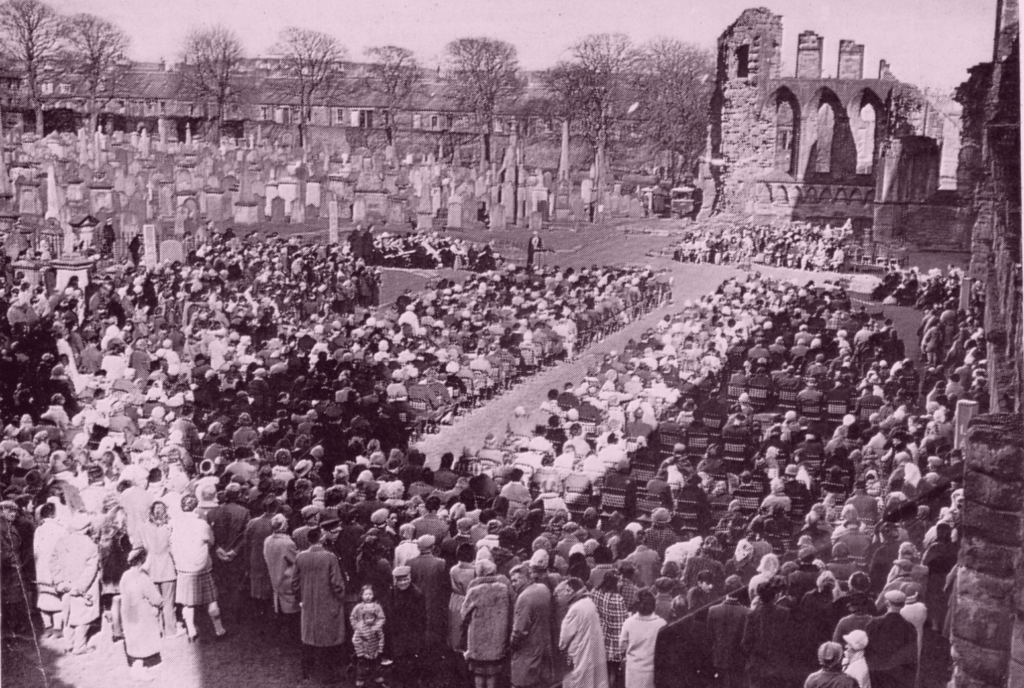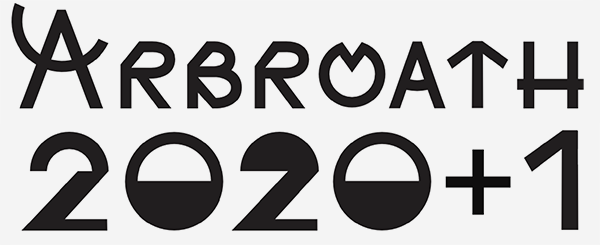An article written and researched by Blythe Stockdale for the online series The Making of a Pageant: 1947-2005.
‘Only a spiritual impulse will keep our pageant alive’…
These were the words with which a local minister addressed the audience at the church service marking the end of Arbroath’s pageant week of 1949. In many ways, 1949 can be seen as a significant year for the Arbroath Abbey Pageant. The event was still in its infancy, having begun in 1947 as a YMCA fundraiser for servicemen still stationed abroad after the Second World War, and yet it was quickly growing into a popular, large-scale and highly technical spectacle. In fact, 1949 would mark the end of the pageant’s days as a fundraiser event. From this point onwards the Arbroath Abbey Pageant Society would ensure any income raised by the pageant was channeled back into their budget, allowing them to create bigger and better performances each year.
The pageant of 1949 already showed signs of this expansion. The organisers had always aimed to educate locals about their civic history – and to attract tourists to the town- by using historical pageantry to depict the signing of the Declaration of Arbroath. Each year the performance was held in the ruins of Arbroath Abbey- the site where the Declaration may have been drawn up by the Abbot of Arbroath. In 1949 this presentation of civic history grew to include three ancillary historical tableaux introduced before the main signing scene, one of which showcased St Ninian meeting with a Picitsh chief to bring Christianity to Angus.

St Ninian would appear again in the pageant events of 1951 as part of a procession of floats displaying historical events. Historical religious figures were a fairly common feature of mid-twentieth century pageants. Take, for example, the Pageant of Angus held in 1930 by the local branches of the Women’s Rural Institute. This pageant featured a similar scene of Pictish heathens being converted, this time by St Fergus, whilst John Knox- founder of the Presbyterian Church of Scotland and leader of the Scottish Reformation- was present in another scene. However, the religiosity of the Arbroath Abbey Pageant seems to have gone beyond the standard content of its contemporaries.
The Abbey Pageant was, of course, attempting to convey an accurate image of life at the Catholic Abbey in 1320, and the ceremony which would have been carried out when writing a letter to the head of Western Christendom and sending it off to the papal court. The presence of costumed actors appearing as an Abbot, a Bishop, and a chorus of chanting monks was therefore necessary to achieve this image. But even before the historical pageantry had begun, audience members were met with a similar tone of solemnity and ceremony in the form of a religious service. Throughout the forties, fifties and sixties each performance of the Arbroath Abbey Pageant was prefaced by a reverend leading the audience in prayer and inviting them to join in with signing select verses from Psalm XXIII. Following this, a second reverend delivered a Dedication and Benediction.

Reference: Angus Alive Archives. 747_18_909
The end of pageant week was marked by a Thanksgiving Sunday service held at the abbey, and, as mentioned at the beginning of this article, the Sunday service of 1949 included a particularly ardent address from a local minister concerning the spiritual nature of the pageant. In his speech the minister stated that because the performance was taking place in a house of God, it was vital that an act of worship was included in the event so that the Abbey continued to be properly regarded as such. He went on to warn that if the pageant would be ‘doomed’, should it ever be “divorced from the act of worship” and be presented solely for entertainment purposes, stating: “Spiritually, it must die. Only a spiritual impulse will keep our pageant alive…”.
By 1955 the opening religious service had been cut from the pageant’s introduction, however, this Sunday service remained in place. Interestingly, after a hiatus from 1956-1964, the return of the pageant in 1964 saw the introductory service being reinstated.
Arbroath’s pageant was not the only one to include a Sunday Service as part of its associated events around this time. For example, Perth’s Historical Pageant of 1949 also ended its pageant week with a church service. This pageant, like Arbroath’s, was held as YMCA fundraiser, with a Pageant Master who had previously been involved in organising Arbroath’s pageant of 1947. And yet, despite the commonalities between the organisation of these events, Perth’s pageant differed from Arbroath’s in that it contained no introductory religious services; there were no prayers, psalms or dedications to frame the main performance, and no notably impassioned speeches at the Sunday service concerning a need for the pageant to maintain a spiritual impulse. This pageant took place in a park; a setting which perhaps did not warrant an act of worship- unlike the environment of Arbroath’s pageant. If we consider the view of the minister warning of the doom which awaited Arbroath’s pageant, should it ever fail to respect its surroundings, it is possible the increased religious services found in Arbroath’s pageants from 1947-1966 were due to a desire to treat this sacred space with the proper worship it deserved. However, the Abbey’s history as a site of Catholic worship may have played into this desire to open and close the pageant with a Presbyterian service.
Up until the Scottish Reformation Arbroath Abbey had functioned as a highly powerful and wealthy Catholic monastery. Founded in 1178 by William the Lion; the Abbey owned vast amounts of land and held the privilege of housing the Monymusk Reliquary- believed to contain the bones of St Columba. The Abbey ceased to operate after the Reformation of 1560. The building was quarried for its sandstone bricks in order to construct a new burgh church and tolbooth and soon fell into ruin as a result.

SCRAN ID: 000-000-144-038-C
Though the pageant was taking place in a derelict abbey, this space was loaded with the Abbey’s past status. Moreover, audiences were presented with powerful figures from the Abbey’s past in the form of actors playing Catholic clergymen, whilst the use of floodlights directed across the Abbey’s walls worked to create a dramatic illusion of the building being roofed once again. This impressive spectacle worked well to convey the former glory of the medieval Abbey to the audience.

Writing on Arbroath’s Pageant of 1949, Linda Fleming suggests the religious service held before each performance may have been an attempt to mitigate the display of Pre-Reformation Catholicism in the largely Protestant twentieth-century Arbroath. She writes:
Yet what the Minister did not mention of course, is that the house of God in question was once a Roman Catholic place of worship […] the Presbyterian churches therefore had good reason to assert their influence forcefully within any ceremony that took place in this iconic building.
Linda FLeming, 2020
The opening act of worship certainly set the tone for each performance. This, coupled with the closing Sunday service at the end of each pageant week, created a Presbyterian framing to the pageant and its display of the Abbey in all its Catholic ceremonial splendour. This desire amongst organisers and local reverends to maintain a Presbyterian influence throughout the pageant hints at a possible underlying fear amongst the townspeople at this time- that the pageants could give way to promoting Catholicism and support of the Papacy. This tension would become apparent at a church service in the Abbey in 1970.
1970 marked the 650th anniversary of the Declaration of Arbroath and inspired a number of commemorative events to be held all over Scotland. This included the return of Arbroath’s Pageant after a 4 year break. The Pageant was planned to run at the height of the holiday season in August, as it had in previous years, meaning that it would miss the actual anniversary date of the Declaration being drawn up on the 6th April. However, an interdenominational church service was held in the abbey on the 6th April 1970 to commemorate this important anniversary. Representatives from local churches were invited to the service, including a Cardinal.

This inclusion of a Catholic representative shows a move towards increased religious diversity in Arbroath’s treatment of its Abbey and the Declaration, however, one group made their opposition to this change very clear. Protestant extremist Pastor Jack Glass, leader of the Twentieth Century Reformation Movement, turned up with a number of followers to protest against the interdenominational service with cries of “No popery”. His anti-Catholic fundamentalism seems to have found little support at the Abbey’s church service, and police were called to remove the group. The Pageant taking place later that year did not include an act of worship. This was perhaps due to the large service which had already been held in April, or perhaps the organisers wished to avoid any more sectarian disruptions; whatever the reason was, the pageant ran smoothly and enjoyed a successful year. From this point onwards all following Arbroath Abbey Pageants would take place without an opening act of worship. Gone were the prayers, dedications and psalms, and, some may argue, the “spiritual impulse” of the pageant. Even without Presbyterian framing the Pageant lived on into the 21st century, with organisers and attendees still being driven by a desire to celebrate the town’s history.
Blythe Stockdale is a writer from Angus who worked with Arbroath 2020+1 to research the history of Pageants in Arbroath and developed a series of local historical walks for the Festival.




